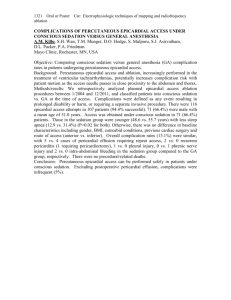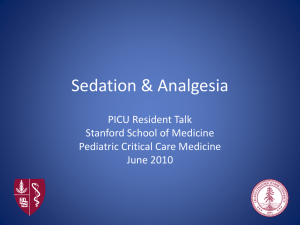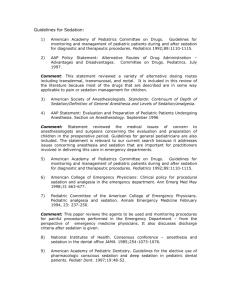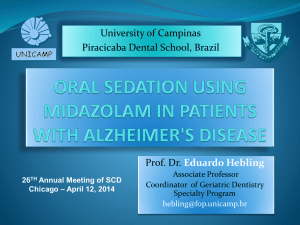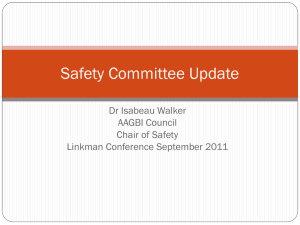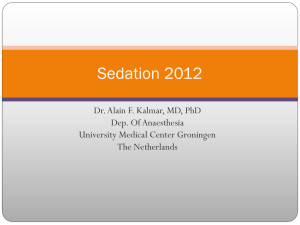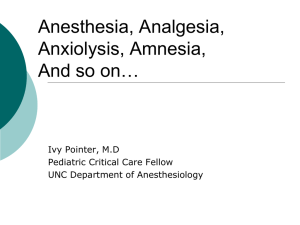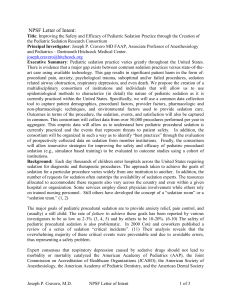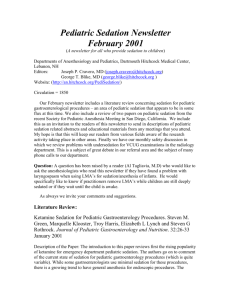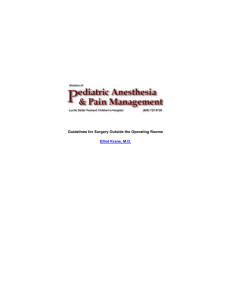Emergency Medicine Related - Dartmouth
advertisement
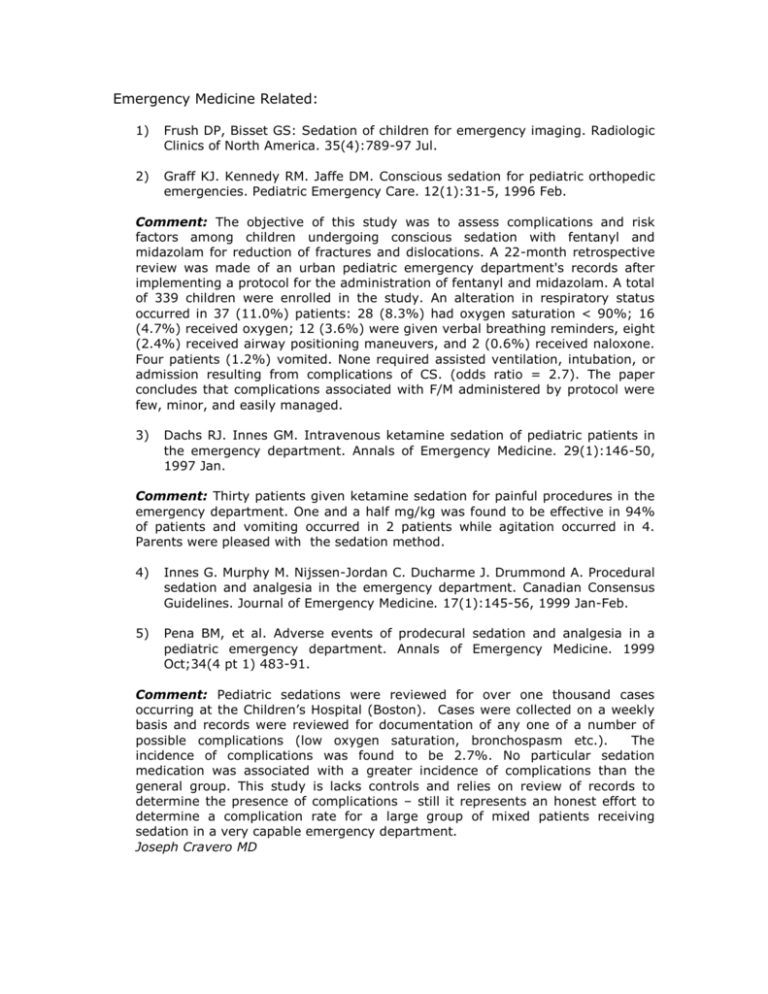
Emergency Medicine Related: 1) Frush DP, Bisset GS: Sedation of children for emergency imaging. Radiologic Clinics of North America. 35(4):789-97 Jul. 2) Graff KJ. Kennedy RM. Jaffe DM. Conscious sedation for pediatric orthopedic emergencies. Pediatric Emergency Care. 12(1):31-5, 1996 Feb. Comment: The objective of this study was to assess complications and risk factors among children undergoing conscious sedation with fentanyl and midazolam for reduction of fractures and dislocations. A 22-month retrospective review was made of an urban pediatric emergency department's records after implementing a protocol for the administration of fentanyl and midazolam. A total of 339 children were enrolled in the study. An alteration in respiratory status occurred in 37 (11.0%) patients: 28 (8.3%) had oxygen saturation < 90%; 16 (4.7%) received oxygen; 12 (3.6%) were given verbal breathing reminders, eight (2.4%) received airway positioning maneuvers, and 2 (0.6%) received naloxone. Four patients (1.2%) vomited. None required assisted ventilation, intubation, or admission resulting from complications of CS. (odds ratio = 2.7). The paper concludes that complications associated with F/M administered by protocol were few, minor, and easily managed. 3) Dachs RJ. Innes GM. Intravenous ketamine sedation of pediatric patients in the emergency department. Annals of Emergency Medicine. 29(1):146-50, 1997 Jan. Comment: Thirty patients given ketamine sedation for painful procedures in the emergency department. One and a half mg/kg was found to be effective in 94% of patients and vomiting occurred in 2 patients while agitation occurred in 4. Parents were pleased with the sedation method. 4) Innes G. Murphy M. Nijssen-Jordan C. Ducharme J. Drummond A. Procedural sedation and analgesia in the emergency department. Canadian Consensus Guidelines. Journal of Emergency Medicine. 17(1):145-56, 1999 Jan-Feb. 5) Pena BM, et al. Adverse events of prodecural sedation and analgesia in a pediatric emergency department. Annals of Emergency Medicine. 1999 Oct;34(4 pt 1) 483-91. Comment: Pediatric sedations were reviewed for over one thousand cases occurring at the Children’s Hospital (Boston). Cases were collected on a weekly basis and records were reviewed for documentation of any one of a number of possible complications (low oxygen saturation, bronchospasm etc.). The incidence of complications was found to be 2.7%. No particular sedation medication was associated with a greater incidence of complications than the general group. This study is lacks controls and relies on review of records to determine the presence of complications – still it represents an honest effort to determine a complication rate for a large group of mixed patients receiving sedation in a very capable emergency department. Joseph Cravero MD 6) Ilkhanipour K. Juels CR. Langdorf MI. Pediatric pain control and conscious sedation: a survey of emergency medicine residencies [see comments]. Academic Emergency Medicine. 1(4):368-72, 1995 Jul-Aug. 7) Petrack EM, Christopher NC, Kriwinsky J. Pain management in the emergency department: patterns of analgesic utilization. Pediatrics. 1997;99:711-714. 8) Selbst SM, Clark M. Analgesic use in the emergency department. Ann Emerg Med. 1990;19.1010-1013. 9) Andrews JS. Conscious sedation in the pediatric emergency department. Curr Opin Pediatr. 1995;7:309-313. 10) Binder LS et al. Chloral hydrate for emergent pediatric procedural sedation: a new look at an old drug. Am J Emerg Med. 1991 Nov;9(6) 21-6. 11) Terndrup TE, Cantor RM, Madden CM. Intramuscular meperidine, promethazine, and chlorpromazine: Analysis of use and complications in 487 pediatric emergency department patients. Ann Emerg Med. 1989;18:528533. 12) American College of Emergency Physicians: Clinical policy for procedural sedation and analgesia in the emergency department. Ann Emerg Med May 1998;31 663-677. 13) Hart LS. Berns SD. Houck CS. Boenning DA. The value of end-tidal CO2 monitoring when comparing three methods of conscious sedation for children undergoing painful procedures in the emergency department. Pediatric Emergency Care. 13(3):189-93, 1997 Jun. Comment: This paper looked at 40 patients randomly assigned to receive one of three sedation medication regimens for painful procedures in the ED. Capnography was used along with oxygen saturation to monitor respiratory depression. The study found a surprisingly high rate of respiratory depression when fentanyl was used as part of the medication scheme 20-23% and CO2 end tidal monitoring allowed early detection of respiratory depression. 14) Anonymous. Use of pediatric sedation and analgesia. American College of Emergency Physicians. Annals of Emergency Medicine. 29(6):834-5, 1997 Jun. 15) Schutzman SA. Liebelt E. Wisk M, Burg J: Comparison of oral transmucosal fentanyl citrate and intramuscular meperidine, promethazine, and chlorpromazine for conscious sedation of children undergoing laceration repair. Annals of emergency Medicine. 28(4): 385-90 1996 Oct. Comment: Little difference between these meds were found. OTFC had more O2 desaturation, more vomiting in the OTFC group and more somnolence in the MPC group. 16) Pohlgeers AP, Friedland LR, Keegan-Jones L: Combination fentanyl and diazepam for pediatric conscious sedation. Academic Emergency Medicine. 2(10):879-83, 1995 Oct. Comment: A retrospective study of the effectiveness and complications of this combination. Desaturations seen when higher doses of fentanyl are used. 17) Havel CJ Jr. Strait RT. Hennes H. A clinical trial of propofol vs midazolam for procedural sedation in a pediatric emergency department. Academic Emergency Medicine. 6(10):989-97, 1999 Oct. Comment: A prospective blinded study comparing midazolam and propofol as sedative in addition to morphine in the emergency department. Propofol was effective and has a much shorter recovery time than midazolam. Brief periods of O2 desaturation were more common in the propofol group. 18) Chudnofsky CR. Safety and efficacy of flumazenil in reversing conscious sedation in the emergency department. Emergency Medicine Conscious Sedation Study Group. Acad Emerg Med. 1997 Oct; 4(10):944-50. 19) Smith JA, Santer LJ. Respiratory arrest following intramuscular ketamine injection in a 4-year-old child. Ann Emerg Med. 1993;22:613-615. 20) Hart LS. Berns SD. Houck CS. Boenning DA. The value of end-tidal CO2 monitoring when comparing three methods of conscious sedation for children undergoing painful procedures in the emergency department. Pediatric Emergency Care. 13(3):189-93, 1997 Jun. Comment: This paper looked at 40 patients randomly assigned to receive one of three sedation medication regimens for painful procedures in the ED. Capnography was used along with oxygen saturation to monitor respiratory depression. The study found a surprisingly high rate of respiratory depression when fentanyl was used as part of the medication scheme 20-23% and CO2 end tidal monitoring allowed early detection of respiratory depression. 21) Sacchetti A, Schafermeyer R, Gerardi M, et al. Pediatric analgesia and sedation. Ann Emerg Med. 1994;23:237 250. 22) Selbst SM. Analgesia in children. Why is it underused in emergency departments? Drug Saf. 1992;7:8-13.

